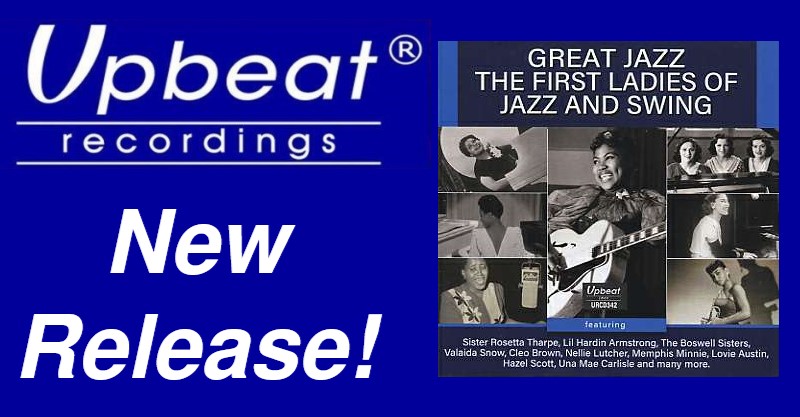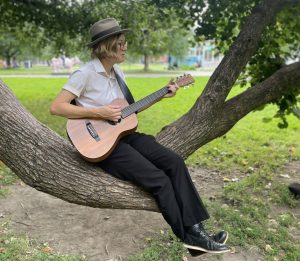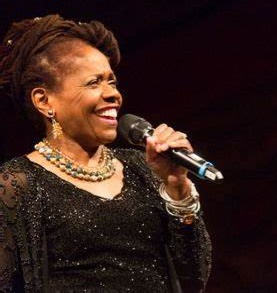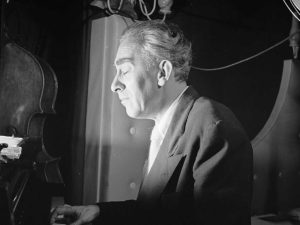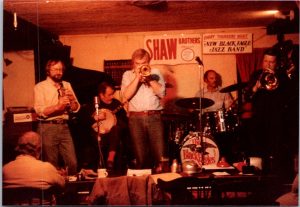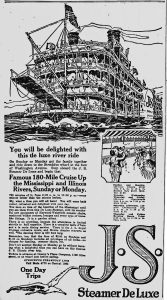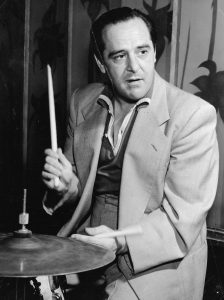Along with the dearth of jazz clubs around the country, especially clubs which feature anything resembling traditional jazz, another venue for the music that has all but disappeared is the Sunday afternoon jazz society meeting. Yes, there are still a few meetings taking place around the country, but the audiences are admittedly older—even elderly now—and the numbers are dwindling. That’s too bad. However, in the 1970s, when I first began learning about the music, they were happy, thriving places where one could go hear the music, and socialize with the musicians and other friends.
Back then, there were jazz society meetings all over Los Angeles and just south of there, down in Orange County. Each club would meet on a specific Sunday of the month. So, a fledgling trombonist like myself could attend the Jazz Forum meeting (for instance) on the first Sunday of the month. The following weekend was the selected Sunday for the uber-trad New Orleans Jazz Club of southern California. A given month’s third Sunday was the day of the Hot Jazz Society, which met at Larchmont Hall on the border of Hollywood and…not Hollywood. And on and on.
The venues were always Elks lodges, or Knights Of Columbus halls. Moose lodges. These venerable organizations would meet in big old rooms, some having been built expressly for them in the early years of the 20th Century. The older places would always have a stage of sorts, and the various societies would usually invest in: a drum set; a string bass; and a piano for their Sunday sessions. There would often be amplifiers provided for the bassists and guitarists.
Those amps would confound the trad fans and so-called mouldy fygges in the audience. I recall a few shouting matches at the South Bay club, when a guitarist would plug in an amp, or an unwanted tenor sax player(!) would call a tune like “Perdido” or “Satin Doll.” The mouldy fygges would start loudly protesting, and the poor unwelcome souls would have a hard time with the names being spouted: King Oliver; Freddie Keppard; Johnny Dodds. “Who cares about those guys? All we want to do is jam, man!” A fracas like this was great fun for a high school kid, believe me!
The format for each Sunday afternoon session was essentially the same. Admission back then was one or two dollars if you were a “foot-stomper.” Musicians were admitted for free. Upon entering, musicians would find the appointed Musical Director for that particular meeting. The MD would usually have a clipboard, with the names of the various instruments in neat columns on a piece of paper. He would ask your name, and find out what instrument you played. He’d list you under your given instrument. Once he had a couple of names under each instrument on his list, he’d assemble an impromptu band: trumpet; clarinet; trombone; piano; bass; drums. Maybe a sax; maybe guitar, or banjo. Sometimes vibes, or a violinist would show up. Often a singer or two. (There was a guy who showed up occasionally with a bugle. Most of the clubs would let him toot away for a couple of tunes. He was terrible.)
The MD would also let each band know how many tunes they were to play; usually three or four songs, then on to the next band.
There was no written music of any kind, except you’d occasionally see a guitarist or bassist come in with a music stand and a few “fake books,” which contain musical “road maps” for the more common songs musicians like to play.
One afternoon, I was sitting with my parents, waiting to be called up to the stage. I saw Joe Darensbourg walk in, holding a small clarinet case. Shortly after that, Mike DeLay—who had played on the New Orleans riverboats on the Mississippi with A. J. Piron’s band—walked in with a compact trumpet case. Then a middle-aged guy worked his way through the audience with a guitar case. He was also trying his best to carry a big, heavy music stand; a stand light; a ling extension cord; and several spiral-bound “fake” books, which are books of popular songs notated in short-hand fashion; just the melody, lyrics, and chord changes. They’re designed for gigging, to help you through tunes you might not know. He also had a stand for his guitar, for it’s easier to turn pages in a book if you can set your guitar down someplace.
A switch flipped in my mind, and I realized that Mr. Darensbourg, Mr. DeLay, and most of the other musicians didn’t have any written music with them. They must know the songs they’re going to play by heart! I realized that if I learned as many songs as I could—the ones that might be called—I wouldn’t have to travel with music stands and piles of music books. Besides, it looked a lot “cooler” to just walk in with your horn. When you’re fifteen, looks count for a lot! So, I started learning as many songs as I could. I wish I knew more.
Since the bands were largely assembled at random, the music would, shall we say, vary in quality. The musicians onstage might be a couple of retired pros; one or two well-meaning amateurs; and perhaps a guy behind the drums who saw a photo of a drum set in a Sears-Roebuck catalog, and thought, “What the hell, I’ll give it a try!”
Can you imagine the opportunity this gave a young, beginning musician? It was a “sink-or-swim” method. You got up there on the stage with several other musicians. Maybe you knew a couple of them; maybe you didn’t know anyone! Maybe you knew the tunes, or maybe you didn’t. I tried not to be stumped more than once on a particular tune. I’d write down the title, and go home and learn it. I didn’t want to be like Guitar-Guy!
All of the clubs were racially integrated, but the club that I remember being special in this regard was the Hot Jazz Society, which was founded in 1949 by the late Floyd and Lucille Levin. When you walked upstairs to the second level of Larchmont Hall, you saw rows of the old Formica-topped “multi-purpose room” tables set length-wise across the room. Chairs were set rather tightly along the tables. The kitchen was in back. I’m hazy on the menu, but I think they had stuff like hot dogs and potato salad for sale, and of course beer and other beverages were available. The thing I noticed was that the audience was about an equal mix of Blacks and Whites. Everyone sat together. It wasn’t Blacks sitting on one side of the room and Whites on the other, or anything like that. Everyone was together, sharing their common love of the music, and everyone seemed glad to be there. I’ll never forget that.
So this is how I met—and got to play with—the legendary clarinetists Joe Darensbourg and Barney Bigard. There were so many others: I’ve already mentioned Mike DeLay, who also played good string bass; Andy Blakeney, another great trumpet player who had actually played with King Oliver in the 1920s, and who had heard and known cornetist Freddie Keppard! Andy had played with Lionel Hampton in the 1930s, and had a long stint with Kid Ory’s Jazz Band, working with Ory beginning in the mid-’40s through sometime in the ’50s. Shortly after I met him, Andy was kind enough to drive down to Newport Harbor High School when I presented a New Orleans-styled jazz band as part of my U.S. History “term project.”
There was another special man I met through the jazz societies. I performed with him at those meetings, and later enjoyed playing with him for many gigs around Los Angeles. He was the trumpeter George Orendorff.
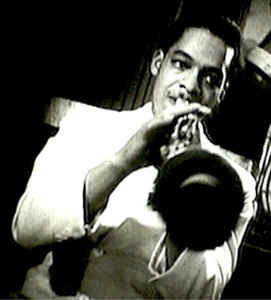
In my memory, George wears only dark brown suits and gently-patterned brown ties with plain white dress shirts. His shoes—brogues—are a lighter brown. The way they were shined would have made General Patton insecure.
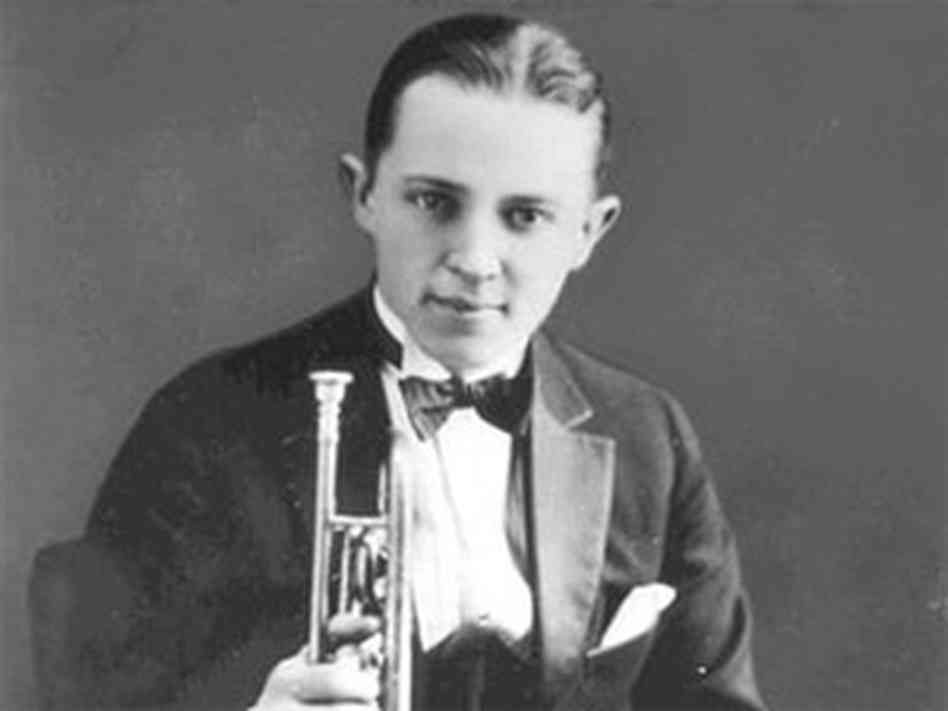
It might be somewhat odd to note that facially, George resembled the cornetist Bix Beiderbecke. Not his coloring—for George had light brown skin, splashed with faint freckles—but rather his features. George had a somewhat narrow, flat nose like you see in photos of Bix, and—like Bix’s—his ears stuck out a bit. Not comically, but still noticeably, just like Bix’s and Bing Crosby’s. But the real resemblance—for me, anyway—were the way George’s eyes popped out, very much like Bix’s. They both often looked surprised by something.
George had probably been wearing his hair the same way since the 1930s: close-cropped, and with a severe part that ran from above the middle of his right eyebrow to the back of his head. His hair was salt-and-pepper, and I don’t recall his ever dyeing it.
I found out later that George had played and recorded with an outstanding band that was based in southern California: Paul Howard’s Quality Serenaders. In 1929 and 1930, the band made some terrific sides for RCA Victor. George was the featured trumpet player in the band, but there were at least two other men in the group who would go on to make names for themselves in the jazz world.
One was the band’s trombonist, Lawrence Brown. Brown played fabulously on these recordings. In 1932, he joined Duke Ellington’s Famous Orchestra, with which he performed and recorded—with an occasional hiatus—for the next four decades.
The other soon-to-be star in the band was their drummer, Lionel Hampton.
Around 1930, Louis Armstrong made his way to Culver City, California, as the main attraction at Sebastian’s Cotton Club; not to be confused with the Cotton Club in New York City. The backing band was none other than the Quality Serenaders.
I don’t know the details, but for some reason the band was taken over by saxophonist Les Hite. Hite retained most of the musicians, but with a few personnel changes, the group began touring and recording under Hite’s name.
Armstrong’s Los Angeles recordings were labeled as, “Louis Armstrong with Les Hite and his Orchestra.”
Back in New York City, Armstrong had been recording with the great Luis Russell Orchestra. Russell was an excellent pianist and arranger—originally from Panama—who had put together a top-notch jazz band that included half a dozen New Orleanians. Russell’s daughter, Catherine Russell, is currently an important and highly-regarded performer on today’s jazz scene.
Around 1935, members of the Les Hite bands and Luis Russell’s outfit merged into what became the Louis Armstrong Orchestra, and began recording jazz classics for the Decca record label. George Orendorff was a member of that band, and is in the trumpet section behind Louis on most of those historic, mid-’30s Decca recordings.
One afternoon, I was in my ’66 Mustang, on my way to a gig. I was excited about the band that day, for George Orendorff would be on trumpet, and there would be several other guys I admired in the band. It was about an hour’s drive or so to Los Angeles, and I was listening to the radio. Back then, one could often hear jazz on the jazz stations. (Ahem).
I certainly found jazz on the jazz station that afternoon, in the form of a 1930 recording by Armstrong with Hite’s band. The title was, “You’re Lucky To Me,” a good song by composer Eubie Blake and lyricist Andy Razaf.
I’d heard that record many times by then; it’s a classic! But this one day, I finally noticed something I hadn’t before.
On that recording, Louis plays the first chorus, solo. The band then plays an interesting eight-bar interlude. The last two bars of that interlude are a “break” for trumpet, in which the whole band abruptly stops, and the trumpet plays two measures by himself.
Louis begins singing right after this trumpet break.
Being young and naïve, I’d always assumed it was Louis himself who played that break. After all, it was his record, right? But that day, I finally realized there is a slight overlap: Louis comes in singing just as the trumpet player ends the “break.”
Now, this was years before “overdubbing,” or the technical wizardry that would make something like this possible. (In fact, on the 1950s album Satch Plays Fats, you can hear Louis encourage HIMSELF to play a solo, after you hear Louis’s trumpet backing his own vocal). Well, this wasn’t possible in 1930. It had to have been the other trumpet player on the date, and that would have been George Orendorff!
I arrived at the gig. I parked my Mustang, and got my trombone case out of the back seat. I threw on the necktie my father had loaned me for the occasion, put on my polyester jacket (you dig?), and went into the building where we were to perform. (No, I don’t remember.)
Mr. Orendorff was already there. He was sitting by himself at a table, in front of the stage (I remember a small bandstand of some kind), quietly blowing warm air through his horn.
The other band members arrived within a few minutes of each other. We were all there, and here it was about an hour before the gig. Old-time pros, man!
So, we’re all sitting around having coffee (or maybe a discreet beer), and I said,
“Mr. Orendorff, may I ask you a question?”
He smiled and said, “Sure, Danny! How’s your parents? What do you want to know?”
I told him I’d been listening to the radio on the drive up, and I’d just heard Louis Armstrong’s record of “You’re Lucky To Me.” George nodded.
“Mr. Orendorff, I figured out Louis couldn’t have played that break before his vocal. By any chance is—”
“Yeah, that’s me! I make that break just before Louis’s vocal!”
We all sat there, realizing we were about to get on stage with a man who played on many jazz classics with one of the greatest artists of the 20th (or 21st) Century.
George looked around, and looked at his watch.
“We still have some time. Can I…can I tell you all about that recording session, and what that man did for me?”
We all nodded our heads, and George began.
“That was my first session with Louis,” he said. George pronounced Armstrong’s first name “Lou-iss,” which I found out years later is how Armstrong himself preferred his name to be said.
George continued. “I got to the studio and warmed up, but I was nervous, man. “See…he was already a star. The rest of the guys were plenty excited, but me, I was scared to death!”
All the musicians finally arrived, and the arranger started passing out the parts for the first tune we was gonna record. It was, “You’re Lucky To Me.” Well, I looked at my part, and right there after the first chorus, it said, ‘make a solo break,’ an’ there were some hash marks written for two measures.”
George explained how in those early days of jazz notation, most arrangements didn’t have chord symbols written out for the jazz soloist. You were a “jazz soloist” because you could play by “ear.”
George went on. “I started sweating, man! I mean, I was real nervous. I went over in the corner of the studio, and started working out a break to play on the record. I didn’t want to try no improvising on a record with Louis Armstrong!
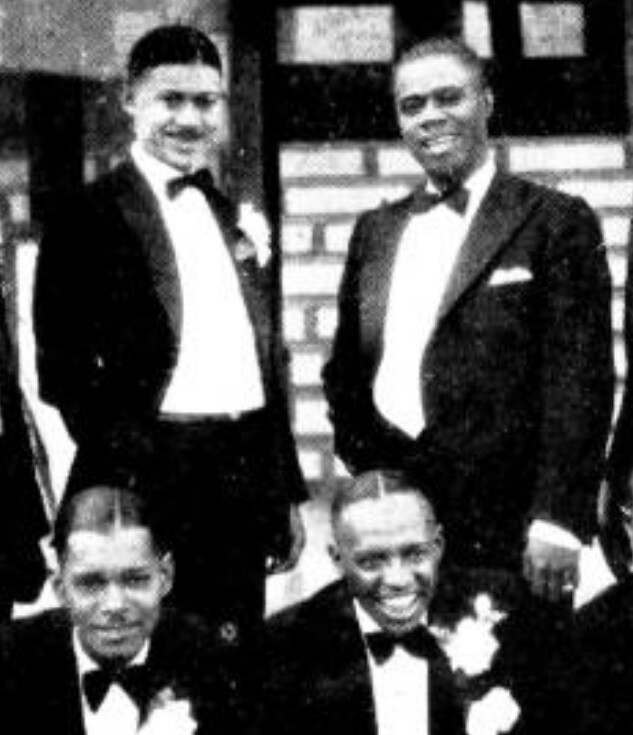
“So, finally Louis comes barging through the door. He was wearing a great big raccoon coat, and a pearl-gray fedora, and he looked sharp, man! Two-tone shoes. He was all smiles. Naturally, everybody wanted to get next to him.
George paused to take a drink of water. He put the water down carefully on its coaster, and continued.
“So, finally Louis gets his horn out of the case and says, ‘What’s first?’ The arranger or producer or somebody said, “You’re Lucky To Me,” Louis!”
Well, Louis looked at his part and says, “Looks OK. Y’know, I played a little earlier, in my room. I think I’m ready to swing out! Let’s just make one!”
In old-fashioned musician-speak, you “made” a recording. The old arrangers I used to know talked about “making” an arrangement for someone. It always seemed like a funny verb to me, but then I guess one doesn’t properly write an arrangement. You make arrangements, don’t you? And I guess you “make” records…or used to.
“So,” George said, “now I was really nervous; like stage fright. Just terrible! My knees were knocking, and I was shaking all over. I thought I was gonna throw up. Then that little red light bulb on the wall went on. That lets everybody know we’re recording, and anyone standing around in the studio had to be quiet until the end.
“So, the musical director stomped us off—silently, of course—an’ we played that nice introduction you hear on the record. Then Louis came in, all warm and swinging. Well, that was great, of course!
“Now we’re getting’ toward the end of the first chorus. I had a few bars off to get ready for my ‘break.’ Man, I was shaking, an’ my mouth was all dry…”
Well, here it was! The break!” George smiled ruefully and looked down and shook his head. “Man,” he said, “I played every note you could think of except any RIGHT ones!”
We all laughed at that. Finally, George was laughing, too, It was a nice thing to see.
“Then, here’s what happened. Louis came in for his vocal, calm as could be. He played the last chorus out; just great, I mean! An’ remember how he slides up to that high note right at the end? An’ we all yell. ‘Yeah!’ That was a G above C, man! Nobody was playing that high on the trumpet then. Nobody!
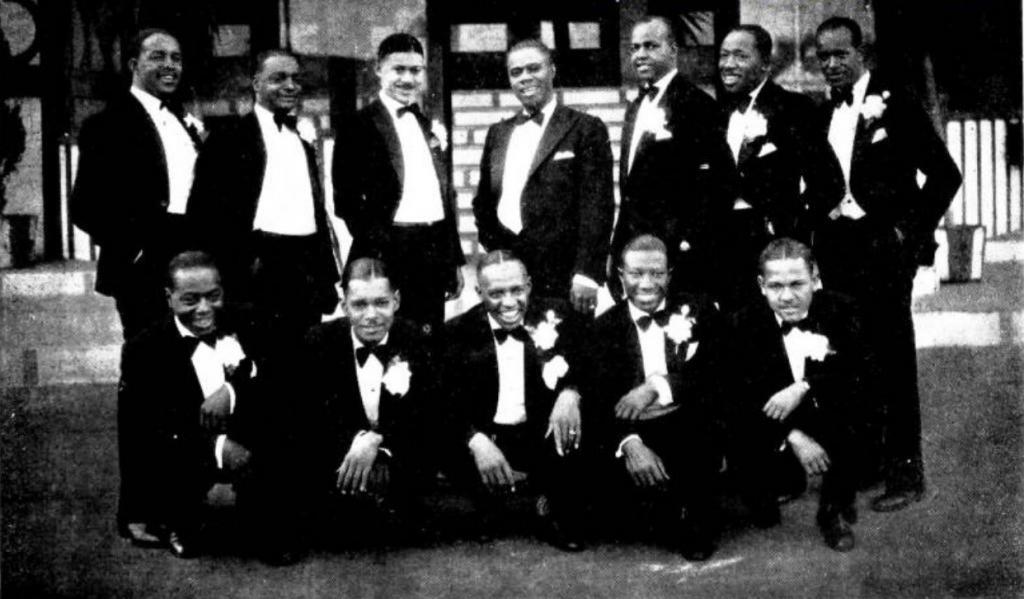
“So, Louis hits that high note; we all yell, “yeah!” and the record’s over. Everyone was quiet for a few seconds—for the recording, you know—an’ then…pandemonium! Everybody’s talkin’ ’bout how great Louis was, an’ how great they all were, an’ ev’rything. All I could do was sit there, lookin’ down at my shoes, figurin’ I was gonna have to live with that awful break I played for the rest of my life.
“Then the A and R man—that’s what we used to call ‘em—‘Artists and Repertoire’ man—he comes into the studio from the recording booth. He says, ‘That was just great, Louis! You got it in just one take! Let’s go on to the next tune!” See, he didn’t care about any young cat messing up two little measures. Louis sounded great, an’ that’s all he needed.”
George shook his head some more, but he was smiling this time. He looked up, and looked around the table at each of us.
“Then you know what that man did for me? Louis Armstrong? He said, ‘Yeah, that was a good one, all right, but I wanna make one more. I’m jus’ gettin’ warmed up, and I think I can make a better one!’”
George looked at us as he said, “Then Louis turned to me, and winked! He winked at me! So, I knew we were gonna make that next take just for me, just so I could make my break the way I wanted. Well, let me tell you, if I was nervous before, I was twice as nervous then! A whole ‘nother take, just for my little two-bar break!
“So, here comes the red light again, and the introduction, an’ Louis sounding just beautiful—again!—and that modulation, an’ then my break. Son of a gun! If anything, it was WORSE than my first one! All wrong notes…
“Louis came in and sang the vocal like nothing happened. Les and Jimmie played their solos like before—good ones, too—and Louis sailed up to that G above high C, and we all yelled ‘Yeah!’
“Out comes the A and R man. Again. He says, “Louis, I don’t know which one I like more! That was great, too! Now we’ve got two great takes of that one. We should move on…’
“Then Louis surprised me, and everybody else in the place. He said, quietly, ‘Well, you know…we’re still ahead of schedule here…I think the rest of the session is gonna go real smoothly. But I want to make just one more of this one. I’m gonna try sumpin’ different on the bridge.. I didn’t like what I did…’
“Now, you gotta take it from me: Louis’s bridge an’ everything else was just terrific. He didn’t need to do NOTHIN” again!”
We all felt his emotion when George looked at us and said, “He was gonna make one more take just for me, so I could finally get that break right!”
George said, “The A and R man shrugged his shoulders, and went back into the booth.
I had a quick talk with myself. ‘George,’ I thought to myself, ‘This man is giving you one more chance. You got to get this right this time; ain’t gonna be no more takes after this one!”
“Red light. Introduction. Louis’s first chorus: perfect! Interlude. Good! Oh, man—here comes my break! An’ I PLAYED it! That two bar break I’d been trying to play all morning. It just came out.
Then Louis sang his chorus; Les and Jimmie played real good solos (they probably knew they weren’t gonna get another chance, neither), an’ Louis played it out, an’ got up to that high G for the third time that morning. We all yelled ‘Yeah!,’ and took a short break for a cigarette and a cup of coffee before the next side.
I heard the A and R man talking with Louis on the break. He said, ‘Louis, you’re in rare form this morning, even for you! Three great takes! It’ll be tough choosing which one to issue..’
“Louis looked at him, all business, and said, ‘Man, I liked that last one; number three! You put a mark by that one on your sheet. Take three. That’s the one to use!”
George was on the verge of weeping. We could see his eyes getting wet. “I’ll never forget what that man did for me that day. I’m not sure he even knew my name back then…”
George took a deep breath, and collected himself.
“Oh, man, I been talkin’ an’ talkin,’ an’ we got to play in just a few minutes! What would you all like to start with?”
There was only one tune on our mind at that point. We opened the evening with “You’re Lucky To Me.”
Dan Barrett is a professional trombonist/ cornetist, arranger, and composer. He enjoys performing in admittedly old-fashioned jazz styles. He has recorded for Concord Records, Arbors Records, and his own Blue Swing Recordings label, among many other labels. Dan fell in love with jazz in high school, and learned to play from much older musicians from New Orleans, who had settled in the Los Angeles area. He has played at Carnegie Hall five times, and was featured in the last bands led by Swing Era icons Benny Goodman and Buck Clayton. Another highlight of Dan’s musical life—so far—was being a member of Lueder Ohlwein’s Sunset Music Company. Write to Dan at: www.DanBarrettMusic.com.




